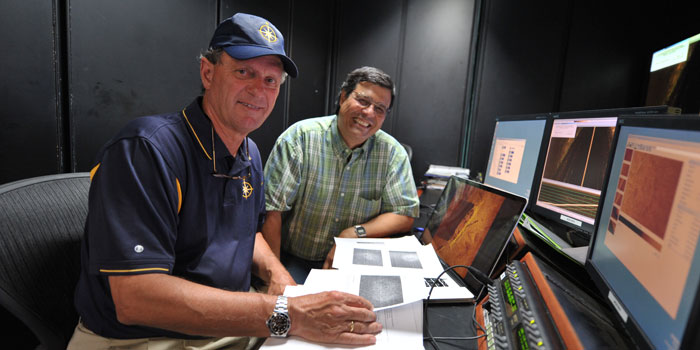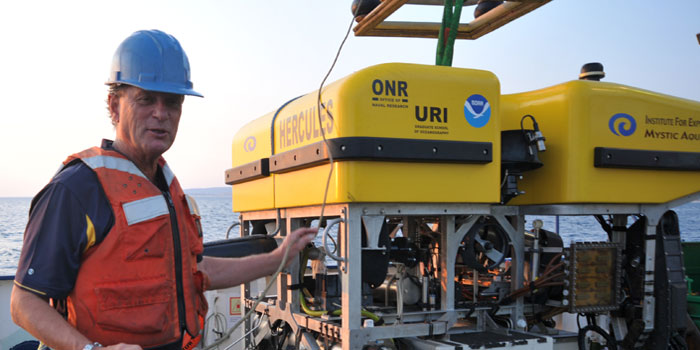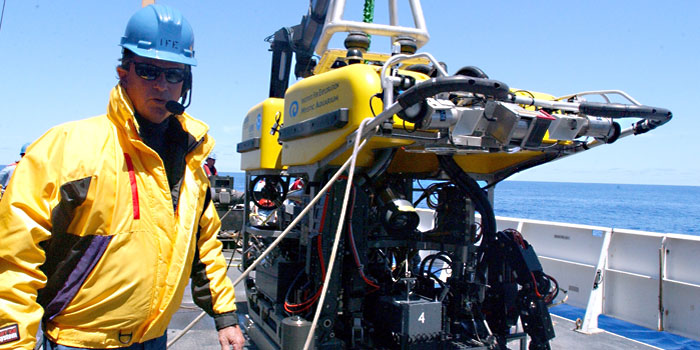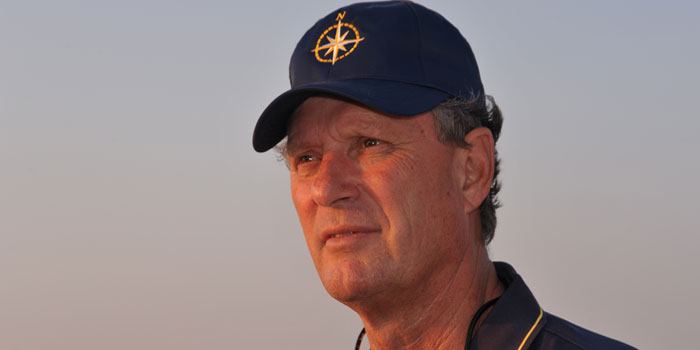Dr. Robert Ballard: Video Transcript
Hear Bob Ballard talk about his job, telepresence, and what it's like to be an ocean explorer. Download (mp4, 337 MB).
Introduction
I am doctor Robert Ballard. Well, I wear a number of hats; one of them is the Institute for Exploration. I am the president. I am also the director of an exciting new program in archeological oceanography at the University of Rhode Island. I have a great title as Explorer in Residence for the National Geographic Society and I also am Chairman of the Board of the JASON Foundation for Education. So I wear four hats.
My mission in life, in fact if you look at my job description, it’s to explore; and since I am a geologist, that means the entire planet, but naturally 72% of it is beneath the sea, so I spend most of my time beneath the sea and I really have two passions: as a geologist naturally I am interested in the natural history of the great mountain ranges, beneath the sea but since finding the Titanic I developed a passion for human history beneath the sea. In fact I am now convinced that there is more history in the deep sea than all the museums in the world combined. And our institute, which is this hat, is the only institute in the world trying to find that history.

From organizing expeditions and finding the funding to actually going out to sea, Bob Ballard's job includes challenges that come in all flavors.
Job Description
I encounter incredible challenges and they come in all flavors. Quite honestly, the greatest challenge is to get the opportunity to go to sea. The politics of it, the fundraising. Once we get out to sea, I mean it’s like that’s the easy part. For many it’s the hard part, for us that’s the fun part. It’s getting ready, organizing expeditions, finding the funding, getting the sponsorship, and then getting the permission from the governments in many cases to enter their waters.
While on the Lost City expedition I was trying an experiment. My greatest challenge was to be quiet, because I don’t like being quiet. And that was to run an expedition and to demonstrate that the people really running it didn’t have to be there. Through technology we now call telepresence, we wanted to demonstrate that because of advances in telecommunication technology we could actually move the chief scientist and all the intellectual brainpower of the expedition onto the beach, and still have it conduct the expedition.
You might ask, “Why would you want to do that?” Well that’s because NOAA and its Office of Ocean Exploration has a new ship coming on line. It’s the Okeanos Explorer. It’s America’s first ship of exploration, and its mission is to go where to no one has gone before. Sound familiar? But, not into outer space, into inner space. Well, if you have a program thats mission is to go where you have never been before, and to discover, you have no idea what you are going to discover. So it’s sort of silly to think you can fill the ship with all the experts, because you’ll probably guess wrong. So we have to have the technology that when we make a discovery in the middle of absolutely nowhere we can instantly beam them aboard the ship. Somewhat like Star Trek when Scotty would say “Beam me down”. We need to be able to beam scientists to the bottom of the ocean anywhere on our planet in a fraction of a second. And to do that we have to have this incredible telecommunication technology. But we never tried it before and Lost City was the first time we ever tried it, and you know what? It worked!

What is Teleprescence? Bob Ballard's thoughts on how technology of telepresence can help to greatly accelerate our rate of ocean exploration.
What is Telepresence?
One of the driving reasons for doing telepresence is for years and years, for over thirty years I went down in submarines and I looked out that window. But I was spending the vast majority of my time in the elevator going to and from work. The average depth of the ocean is 12,000 feet and to get down there in a submarine takes two and a half hours in the morning to get to work and two and a half hours to get home at night, and I only spent three hours on the bottom, and if I was lucky I covered one mile. Well, I’m trying to explore features that are thousands of miles long and with this technology we can put our vehicles down because there is no human being in them. They don’t have to go to the bathroom, they don’t have to go to bed, they don’t have to eat. The robot can stay down constantly and therefore we can explore 24 hours a day, instead of three hours a day.
So that technology of telepresence is going to greatly accelerate our rate of ocean exploration. Also our ability to share it with others through telepresnt technology. I was surprised how quickly they came aboard. I thought that there would be barriers that wouldn’t permit them to make that leap. To leap in fantasy, to be able to jump out of their body and come aboard the ship. I thought there would be much more resistance, but as soon as it got going, and as soon as the action started flowing, and the instant dialogue there were no time delays in the dialogues so it was instant back and forth dialogue. The quality of the imagery that they had, boom they were there much, much quicker than I thought.
What we learned on this expedition was you could really beam people aboard. The complexity is to do it now on a much larger scale. The idea of the Okeannus (spelling) Explorer is that it’s out on a mission in the middle of absolutely nowhere and it makes a discovery. The people aboard are not scientists. They are engineers, they are aquanauts, they are there to operate the technology and to make the initial contact. But then as soon as they make the initial contact, they need to make sure that if they look over their shoulder, the experts are there, or more importantly, they’re in their ear, guiding them. So what we have done is we built and tried for the first time, what we call the Inner Space Center.
We are building it at the University of Rhode Island. And the Inner Space Center is sort of what Houston is to outer space this will be to inner space. And it will be connected constantly to the ship and the ship works 24 hours a day, so the Inner Space Center works 24 hours a day. So imagine that here we are out in the Indian Ocean of the Western Pacific and we make an incredible discovery. We make an archeological discovery, a historical discovery, a new life forms geologic canyon or mountain range and we need to get the expert. Well, the people at the Inner Space Center will then be able to call the expert like we would do with Deb Kelly, who’s an expert on Lost City. Imagine her walking down the hall of the University and her cell phone rings. “ Deb, we just found another Lost City, get to your console, tell us what to do!” So she would go down the hall to her command center, sit down, turn it on, put on a head set and say “ So Todd, what do you have for me?” and that’s what is’s all about. So we took that to a new level on the Lost City expedition. Now we have to implement it not for a ten-day cruise, but for 250 days a year, year in, and year out. And that starts in 2007.

Bob Ballard talks about the equipment and activities that are required to make an expedition happen.
Beyond ROV's and Telepresence
Well before a cruise actually takes place, we have to prep it. Our vans are always at the university and we go in and we get them all ready. And initially they look pretty, you know, not very exciting, a bunch of black screens. But when you turn this room on, it is magical. It’s like going through Alice’s looking glass. That’s basically what we’re doing—we’re standing before Alice’s looking glass. And through the use of these beautiful plasma displays we’re able to make our mental trip down to the bottom of the ocean.
Now the van is really in three different parts. Up front is where the action is, that’s where the pilot of Hercules, that’s where the pilot of Argis is, that’s where the navigator is. They are all doing their thing. Next to them is where all the video switching is coming in because all of this is being sent out on a satellite. I am in the back of the bus. I live in the back of the bus, and that’s where we have our command center.
Now for many, many years when I was using submarines and I would want to turn on something and I would reach up, they would slap my hand and say “Don’t touch anything, don’t touch anything!” the pilot always had the best window and I would always say “could I look out your window” and he would say “No, no look out the side window” it was very frustrating to always having your hand slapped and always asking “Mother may I?” When I designed this system I wanted to make sure no one was ever going to slap my hand again, and I was never going to have to ask again “Mother may I?” So everything is on demand and I can have whatever I want, whenever I want it without asking.
You’ll notice that all of our cameras on all of our vehicles are high definition cameras. That is very important because what we are trying to do is to simulate presence. And we’re competing with what the human eye can see out of the window of a submarine. So it is critical as technology permits, you’re always at that leading edge of video technology. Right now that leading edge is high definition. Will there be something better than high definition? Absolutely, probably stereo high definition. Ultimately, we’re trying to develop technology that replicates the human eye. So that we can create a true telepresence. So at all stages of the game, we are pushing the technology to make sure it is as good as it possibly can be at this moment. Right now, it is fiber optics and high definition camera systems.
You’ll notice commonly and I’m sure you’ve been looking at that we have headsets on. There is a reason for that. Everyone’s communicating with one another. There are all sorts of practical reasons for it, and there are also some scientific reasons, and also opportunities to reach out off the ship. So we have headsets on the people on the bridge because the bridge is driving the ship so we need to talk to them. When we are launching and recovering vehicles it is very important that the people on the deck are talking to the bridge so that they are putting the ship in the right position. They are also having to talk to the pilot because the pilot is a little blind at this moment. They have to sort of talk, sort of walk the pilot through because they don’t want him to crash into the side of the boat. Or worse, there are big props going on down there and the last thing you want your vehicle or your cable connecting your vehicle is to go into those props. So there are a lot of communications going on.
Now once you get the vehicles down, we have sixteen channels that people can come in. And what’s wonderful about our audio system is we can have multiple different conversations. The pilot, because there are two pilots, there is the Hercules pilot, and Argis pilot, and there is ship operator. So there’s always a symphony of voices going on as they’re coordinating. It’s sort of a choreography of dancing vehicles. So they always have to be talking to one another. Well, while that’s going on, the scientists are talking to one another. Because you’re going to have scientists in the command center, but you also have scientists on the beach. And they’re looking at the same monitor. So there are all these conversations between scientists comparing notes, talking to people in the lab, talking to people on the ship, talking to people on the shore. It’s sort of a party line. But then we also use this to do educational programming. We do shows for museums and aquariums, and science centers; for schools, for Boys and Girls Clubs of America. And so we have another set of conversations going on and what I always love to do is sit in the back of the command center, put my microphone on mute so they can’t hear me, and then I listen in on everybody. It’s sort of sneaky, but you get to listen to all the conversations. It’s really wonderful because you really hear true excellence in operation. It’s a quiet excellence, they’re not noisy, they know what they’re doing.
Now once you get the vehicles down, we have sixteen channels that people can come in. And what’s wonderful about our audio system is we can have multiple different conversations. The pilot, because there are two pilots, there is the Hercules pilot, and Argis pilot, and there is ship operator. So there’s always a symphony of voices going on as they’re coordinating. It’s sort of a choreography of dancing vehicles. So they always have to be talking to one another. Well, while that’s going on, the scientists are talking to one another. Because you’re going to have scientists in the command center, but you also have scientists on the beach. And they’re looking at the same monitor. So there are all these conversations between scientists comparing notes, talking to people in the lab, talking to people on the ship, talking to people on the shore. It’s sort of a party line. But then we also use this to do educational programming. We do shows for museums and aquariums, and science centers; for schools, for Boys and Girls Clubs of America. And so we have another set of conversations going on and what I always love to do is sit in the back of the command center, put my microphone on mute so they can’t hear me, and then I listen in on everybody. It’s sort of sneaky, but you get to listen to all the conversations. It’s really wonderful because you really hear true excellence in operation. It’s a quiet excellence, they’re not noisy, they know what they’re doing.

Closing Remarks: "What I like most about life at sea is the epic journey."
Closing Remarks
What I like most about life at sea is the epic journey. The real decoupling with today’s society, leaving today’s society. If you know much about the concept of an epic journey, it begins with a dream, a quest, and a vision. To me it was to be Captain Nemo. But then the consequences of living your dream is that there’s a lot of consequences.
One of them is you have to prepare yourself. That’s what school’s all about- getting ready to go on your epic journey. But then you assemble your team, your Argonauts. It’s not a solo trip. This is not a solo thing, this is a team sport. And you go out with your team and you are challenged. You’re challenged in two ways, you are challenged mentally: did you prepare yourself? Are educated enough for this challenge? And that you can pretty well predict and pass. The hardest one is the test of your heart. Because you’re going to be challenged and you’re going to face failure. You have to overcome failure to reach success. Most people are in failure avoidance, and if they’re in failure avoidance, they are in success avoidance. Failure and success are the yin and yang.
But then you overcome your tests and Neptune shows you the truth, gives you the Golden Fleece. And then the journey’s never over until you return to society and share what you have learned. And that’s what an expedition is all about. You go out with a mission, you assemble your team, you’re tested, you overcome the test, you attain the truth, and you return to society and share it. We’re all on these epic journeys. Everyone’s on an epic journey, ours is just very obvious. So going to sea reinforces the journey we’re all on, which Joseph Campbell so beautifully said, “Life is the act of becoming, one never arrives.” That’s what expeditions should be; you go on an expedition, only to go to the next one and the next one. And hopefully through telepresence a bit you get to go on some of them physically, but most of through telepresence. So I can also go home at night and be with my children and wife.
Return to profile